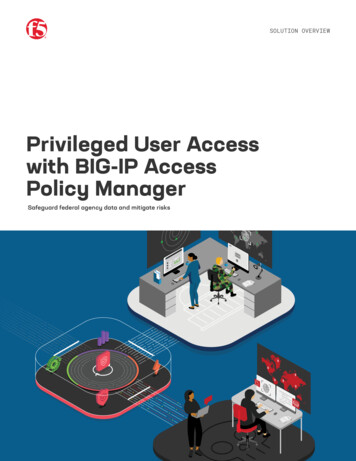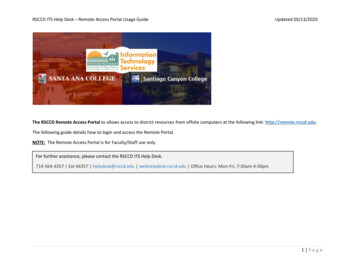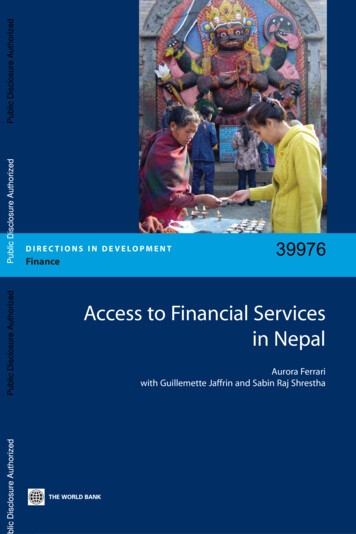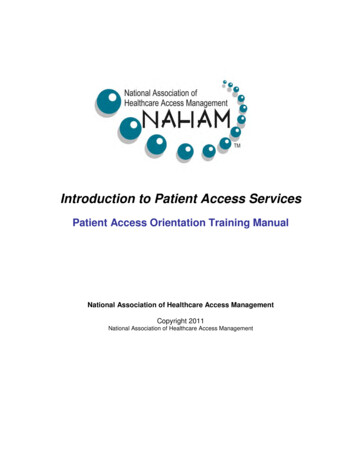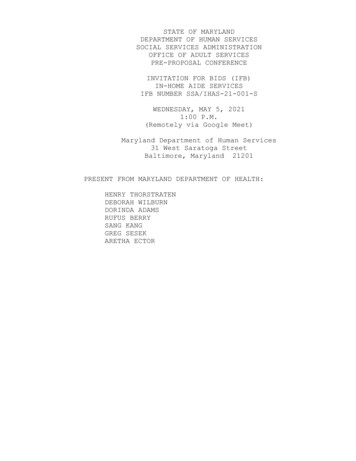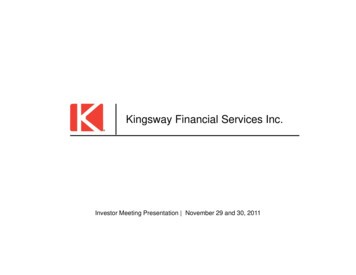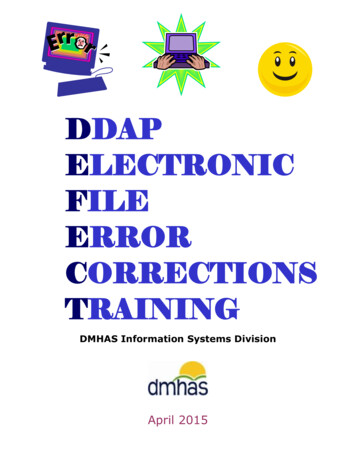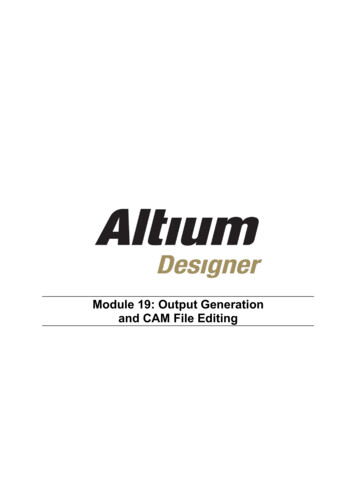![[MS-FASOD]: File Access Services Protocols Overview](/img/10/5bms-fasod-5d.jpg)
Transcription
[MS-FASOD]:File Access Services Protocols OverviewIntellectual Property Rights Notice for Open Specifications Documentation Technical Documentation. Microsoft publishes Open Specifications documentation (“thisdocumentation”) for protocols, file formats, data portability, computer languages, and standardssupport. Additionally, overview documents cover inter-protocol relationships and interactions.Copyrights. This documentation is covered by Microsoft copyrights. Regardless of any otherterms that are contained in the terms of use for the Microsoft website that hosts thisdocumentation, you can make copies of it in order to develop implementations of the technologiesthat are described in this documentation and can distribute portions of it in your implementationsthat use these technologies or in your documentation as necessary to properly document theimplementation. You can also distribute in your implementation, with or without modification, anyschemas, IDLs, or code samples that are included in the documentation. This permission alsoapplies to any documents that are referenced in the Open Specifications documentation.No Trade Secrets. Microsoft does not claim any trade secret rights in this documentation.Patents. Microsoft has patents that might cover your implementations of the technologiesdescribed in the Open Specifications documentation. Neither this notice nor Microsoft's delivery ofthis documentation grants any licenses under those patents or any other Microsoft patents.However, a given Open Specifications document might be covered by the Microsoft OpenSpecifications Promise or the Microsoft Community Promise. If you would prefer a written license,or if the technologies described in this documentation are not covered by the Open SpecificationsPromise or Community Promise, as applicable, patent licenses are available by contactingiplg@microsoft.com.License Programs. To see all of the protocols in scope under a specific license program and theassociated patents, visit the Patent Map.Trademarks. The names of companies and products contained in this documentation might becovered by trademarks or similar intellectual property rights. This notice does not grant anylicenses under those rights. For a list of Microsoft trademarks, visitwww.microsoft.com/trademarks.Fictitious Names. The example companies, organizations, products, domain names, emailaddresses, logos, people, places, and events that are depicted in this documentation are fictitious.No association with any real company, organization, product, domain name, email address, logo,person, place, or event is intended or should be inferred.Reservation of Rights. All other rights are reserved, and this notice does not grant any rights otherthan as specifically described above, whether by implication, estoppel, or otherwise.Tools. The Open Specifications documentation does not require the use of Microsoft programmingtools or programming environments in order for you to develop an implementation. If you have accessto Microsoft programming tools and environments, you are free to take advantage of them. CertainOpen Specifications documents are intended for use in conjunction with publicly available standardsspecifications and network programming art and, as such, assume that the reader either is familiarwith the aforementioned material or has immediate access to it.Support. For questions and support, please contact dochelp@microsoft.com.1 / 59[MS-FASOD] - v20210603File Access Services Protocols OverviewCopyright 2021 Microsoft CorporationRelease: June 3, 2021
Revision 2/20121.0NewReleased new document.10/25/20121.1MinorClarified the meaning of the technical content.1/31/20131.1NoneNo changes to the meaning, language, or formatting of thetechnical content.8/8/20132.0MajorUpdated and revised the technical content.11/14/20132.1MinorClarified the meaning of the technical content.2/13/20142.1NoneNo changes to the meaning, language, or formatting of thetechnical content.5/15/20142.1NoneNo changes to the meaning, language, or formatting of thetechnical content.6/30/20153.0MajorSignificantly changed the technical content.9/24/20154.0MajorSignificantly changed the technical content.10/16/20154.0NoneNo changes to the meaning, language, or formatting of thetechnical content.9/26/20165.0MajorSignificantly changed the technical content.6/1/20175.0NoneNo changes to the meaning, language, or formatting of thetechnical content.12/15/20176.0MajorSignificantly changed the technical content.11/5/20187.0MajorSignificantly changed the technical content.6/3/20218.0MajorSignificantly changed the technical content.2 / 59[MS-FASOD] - v20210603File Access Services Protocols OverviewCopyright 2021 Microsoft CorporationRelease: June 3, 2021
Table of Contents1Introduction . 51.1Glossary . 61.2References . 62Functional Architecture . 92.1Overview . 92.1.1System Purpose . 92.1.2Applicability . 92.1.3System Components . 92.1.4Protocol Communications. 112.1.5Relevant Standards . 132.2Protocol Summary . 142.2.1Member Protocol Roles . 162.3Environment . 172.3.1Dependencies on This System . 182.3.2Dependencies on Other Systems/Components . 182.3.2.1System Influences . 192.4Assumptions and Preconditions . 192.5Use Cases . 202.5.1Access a File in a Workgroup . 202.5.2Access a File in a Domain . 232.5.3Two Applications Communicate via a Shared File . 252.5.4Access a Remote File Using WebDAV . 272.5.5Supporting Use Cases . 292.5.5.1List File Servers . 292.5.5.2List Shares . 302.5.5.3List Files in a Shared Directory - Application . 312.5.5.4Open a File in an SMB File Share - Application . 322.5.5.5Perform a File Operation Using SMB . 332.5.5.6Open a File in an NFS File Share . 342.5.5.7Perform File Operation Using NFS. 362.5.5.8Directory Change Notification Using SMB . 372.5.5.9List Files in a Web Directory . 372.5.5.10Perform File Operation Using WebDAV . 382.6Versioning, Capability Negotiation, and Extensibility . 392.7Error Handling . 392.7.1Connection Disconnected . 392.7.2Internal Failures . 402.7.3System Configuration Corruption or Unavailability . 402.8Coherency Requirements . 402.9Security . 402.10Additional Considerations . 403Examples . 413.1Example 1: Access a File in a Workgroup . 413.2Example 2: Access a File in a Domain . 423.3Example 3: Two Applications Communicate Via a Shared File . 443.4Example 4: Access a Remote File Using WebDAV . 503.5Common Tasks . 513.5.1Common Task 1: Open a File in an SMB File Share . 513.5.2Common Task 2: Enumerate a Directory Using the SMB Protocol . 523.5.3Common Task 3: Read a File Using the SMB Protocol . 533.5.4Common Task 4: Close a File Using the SMB Protocol . 544Microsoft Implementations . 563 / 59[MS-FASOD] - v20210603File Access Services Protocols OverviewCopyright 2021 Microsoft CorporationRelease: June 3, 2021
4.1Product Behavior . 565Change Tracking . 576Index . 584 / 59[MS-FASOD] - v20210603File Access Services Protocols OverviewCopyright 2021 Microsoft CorporationRelease: June 3, 2021
1IntroductionThe File Access Services (FAS) protocols allow applications to access and share files located on a fileserver, using a network between them, in a secure and managed environment. File sharing supportsthe collaborative development of documents, code, or any type of file and their subsequentpublication, distribution, and further evolution. Centralizing file storage on file servers offers severalbenefits, including the following: Centralizes data management, including backup. Supports organizing data in a taxonomy (a file hierarchy) that is meaningful to a community ofusers, instead of requiring users to organize their own copies of the same data. Supports a pull model for document distribution, allowing users to seek out data when needed,rather than have to organize data that is pushed to them, for example, in email. Saves storage and network bandwidth in email systems, by allowing users to refer to files on fileservers, using hyperlinks embedded in email messages.File Access Services can be used for communication between any pair of computers, with onecomputer acting as client and the other as server. A given computer can act as a file services client, afile server, or both.File Access Services is composed of the following member protocols: Common Internet File System, described in [MS-CIFS], which supports the sharing of file and printresources between computers. Common Internet File System (CIFS) Browser Protocol, described in [MS-BRWS], which is used tocommunicate with servers that are acting as clearinghouses for printing and file sharing servicesavailable on the network. Distributed File System (DFS): Referral Protocol, described in [MS-DFSC], which is used by SMBfile clients to resolve paths in a distributed virtual namespace. File System Control Codes, described in [MS-FSCC], which defines the network format of nativeWindows structures used within other protocols such as SMB ([MS-SMB]). NFS: Network File System Protocol, as defined in [RFC1094] version 2, [RFC1813] version 3, and[RFC5661] version 4.1. This protocol supports the sharing of file resources between computers. Network Lock Manager (NLM) and Network Status Monitor (NSM) protocols, as defined in [C702].These protocols are used in conjunction with the NFS file access protocols to provide support forfile locking and service status monitoring. Remote Administration Protocol, as defined in [MS-RAP], which is used for server discovery andremote administration. The administrative functions can use the protocol defined in [MS-BRWS]for server discovery as an alternative to that defined in [MS-RAP]. Server Message Block (SMB) Protocol, as defined in [MS-SMB]. This protocol defines extensions tothe [MS-CIFS] protocol. Server Message Block (SMB) Version 2 and 3 Protocol, as defined in [MS-SMB2]. This protocolshares and extends concepts from [MS-SMB] and [MS-CIFS], but has a completely new andseparate command set. SMB2 Remote Direct Memory Access (RDMA) Transport Protocol, as defined in [MS-SMBD]. Thisprotocol (also called SMB Direct) allows SMB2 packets to be delivered over RDMA-capabletransports such as iWARP, as defined in [RFC5040] section 2.1, or Infiniband ([IBARCH]) while5 / 59[MS-FASOD] - v20210603File Access Services Protocols OverviewCopyright 2021 Microsoft CorporationRelease: June 3, 2021
using the direct data placement (DDP) capabilities, as defined in [RFC5040] section 2.1, of thesetransports. Benefits include reduced CPU overhead, lower latency and improved throughput. File System Algorithms, as defined in [MS-FSA]. The file system algorithms define an abstractmodel for how an object store can be implemented to support the Common Internet File System(CIFS) Protocol, the Server Message Block (SMB) Protocol, and the Server Message Block (SMB)Version 2 Protocol (described in [MS-CIFS], [MS-SMB], and [MS-SMB2] respectively). Microsoft Web Distributed Authoring and Versioning (WebDAV) protocol extensions, as defined in[MS-WDV], [MS-WDVME], and [MS-WDVSE]). These protocols define a set of extensions for boththe WebDAV client and server.1.1GlossaryThis document uses the following terms:primary domain controller (PDC): A domain controller (DC) designated to track changes madeto the accounts of all computers on a domain. It is the only computer to receive these changesdirectly, and is specialized so as to ensure consistency and to eliminate the potential forconflicting entries in the Active Directory database. A domain has only one PDC.1.2ReferencesLinks to a document in the Microsoft Open Specifications library point to the correct section in themost recently published version of the referenced document. However, because individual documentsin the library are not updated at the same time, the section numbers in the documents may notmatch. You can confirm the correct section numbering by checking the Errata.[C702] The Open Group, "Protocols for Interworking: XNFS, Version 3W", C702, February [IBARCH] Infiniband Trade Association, "Infiniband Architecture Specification, Volume 1", Release1.2.1, January 2008, OD] Microsoft Corporation, "Active Directory Protocols Overview".[MS-AUTHSOD] Microsoft Corporation, "Authentication Services Protocols Overview".[MS-BRWSA] Microsoft Corporation, "Common Internet File System (CIFS) Browser AuxiliaryProtocol".[MS-BRWS] Microsoft Corporation, "Common Internet File System (CIFS) Browser Protocol".[MS-CIFS] Microsoft Corporation, "Common Internet File System (CIFS) Protocol".[MS-DFSC] Microsoft Corporation, "Distributed File System (DFS): Referral Protocol".[MS-DFSNM] Microsoft Corporation, "Distributed File System (DFS): Namespace ManagementProtocol".[MS-DTYP] Microsoft Corporation, "Windows Data Types".[MS-FSA] Microsoft Corporation, "File System Algorithms".[MS-FSCC] Microsoft Corporation, "File System Control Codes".[MS-FSMOD] Microsoft Corporation, "File Services Management Protocols Overview".[MS-GPOD] Microsoft Corporation, "Group Policy Protocols Overview".6 / 59[MS-FASOD] - v20210603File Access Services Protocols OverviewCopyright 2021 Microsoft CorporationRelease: June 3, 2021
[MS-PRSOD] Microsoft Corporation, "Print Services Protocols Overview".[MS-RAP] Microsoft Corporation, "Remote Administration Protocol".[MS-RPCE] Microsoft Corporation, "Remote Procedure Call Protocol Extensions".[MS-SMB2] Microsoft Corporation, "Server Message Block (SMB) Protocol Versions 2 and 3".[MS-SMBD] Microsoft Corporation, "SMB2 Remote Direct Memory Access (RDMA) Transport Protocol".[MS-SMB] Microsoft Corporation, "Server Message Block (SMB) Protocol".[MS-SRVS] Microsoft Corporation, "Server Service Remote Protocol".[MS-UNMP] Microsoft Corporation, "User Name Mapping Protocol".[MS-WDVME] Microsoft Corporation, "Web Distributed Authoring and Versioning (WebDAV) Protocol:Microsoft Extensions".[MS-WDVSE] Microsoft Corporation, "Web Distributed Authoring and Versioning (WebDAV) Protocol:Server Extensions".[MS-WDV] Microsoft Corporation, "Web Distributed Authoring and Versioning (WebDAV) Protocol:Client Extensions".[MS-WKST] Microsoft Corporation, "Workstation Service Remote Protocol".[NIS] Sun Microsystems, Inc., "System Administration Guide: Naming and Directory Services (DNS,NIS, and LDAP)", 1001] Network Working Group, "Protocol Standard for a NetBIOS Service on a TCP/UDPTransport: Concepts and Methods", RFC 1001, March 1987, http://www.ietf.org/rfc/rfc1001.txt[RFC1002] Network Working Group, "Protocol Standard for a NetBIOS Service on a TCP/UDPTransport: Detailed Specifications", STD 19, RFC 1002, March 1987, http://www.rfceditor.org/rfc/rfc1002.txt[RFC1034] Mockapetris, P., "Domain Names - Concepts and Facilities", STD 13, RFC 1034, November1987, http://www.ietf.org/rfc/rfc1034.txt[RFC1035] Mockapetris, P., "Domain Names - Implementation and Specification", STD 13, RFC 1035,November 1987, http://www.ietf.org/rfc/rfc1035.txt[RFC1094] Sun Microsystems, Inc., "NFS: Network File System Protocol Specification", RFC 1094,March 1989, http://www.ietf.org/rfc/rfc1094.txt[RFC1813] Callaghan, B., Pawlowski, B., and Staubach, P., "NFS Version 3 Protocol Specification", RFC1813, June 1995, http://www.ietf.org/rfc/rfc1813.txt[RFC1833] Srinivasan, R., "Binding Protocols for ONC RPC Version 2", RFC 1833, August 1995,http://www.ietf.org/rfc/rfc1833.txt[RFC2251] Wahl, M., Howes, T., and Kille, S., "Lightweight Directory Access Protocol (v3)", RFC 2251,December 1997, http://www.ietf.org/rfc/rfc2251.txt[RFC2307] Howard, L., "An Approach for Using LDAP as a Network Information Service", RFC 2307,March 1998, http://www.ietf.org/rfc/rfc2307.txt[RFC4506] Network Appliance, Inc., "XDR: External Data Representation Standard", STD 67, RFC4506, May 2006, http://www.ietf.org/rfc/rfc4506.
the [MS-CIFS] protocol. Server Message Block (SMB) Version 2 and 3 Protocol, as defined in [MS-SMB2]. This protocol shares and extends concepts from [MS-SMB] and [MS-CIFS], but has a completely new and separate command set. SMB2 Remote Direct Memory Access (RDMA) Transport
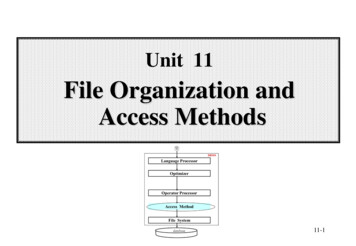
![[MS-ACCDT]: Access Template File Format](/img/10/ms-accdt.jpg)
